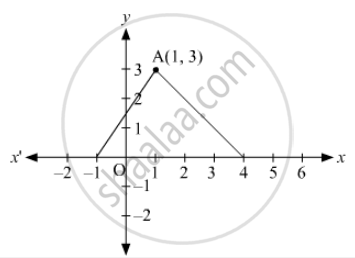Advertisements
Advertisements
प्रश्न
Find the third vertex of a triangle, if two of its vertices are at (−3, 1) and (0, −2) and the centroid is at the origin.
उत्तर
We have to find the co-ordinates of the third vertex of the given triangle. Let the co-ordinates of the third vertex be(x,y).
The co-ordinates of other two vertices are (−3, 1) and (0, −2)
The co-ordinate of the centroid is (0, 0)
We know that the co-ordinates of the centroid of a triangle whose vertices are
`(x_1,y_1),(x_2,y_2),(x_3,y_3)`is
`((x_1+x_2+x_3)/3,(y_1+y_2+y_3)/3)`
So,
`(0,0)=((x+0-0)/3,(y+1-2)/3)`
Compare individual terms on both the sides-
`(x-3)/3=0`
So,
x=3
Similarly,
`(y-1)/3=0`
So,
y=1
So the co-ordinate of third vertex (3,1)
APPEARS IN
संबंधित प्रश्न
How will you describe the position of a table lamp on your study table to another person?
Find a point on the x-axis which is equidistant from the points (7, 6) and (−3, 4).
Find the ratio in which the line segment joining (-2, -3) and (5, 6) is divided by y-axis. Also, find the coordinates of the point of division in each case.
Show that the following points are the vertices of a square:
A (6,2), B(2,1), C(1,5) and D(5,6)
The midpoint P of the line segment joining points A(-10, 4) and B(-2, 0) lies on the line segment joining the points C(-9, -4) and D(-4, y). Find the ratio in which P divides CD. Also, find the value of y.
Find the area of quadrilateral ABCD whose vertices are A(-5, 7), B(-4, -5) C(-1,-6) and D(4,5)
The area of the triangle formed by the points P (0, 1), Q (0, 5) and R (3, 4) is
Points P, Q, R and S divides the line segment joining A(1, 2) and B(6, 7) in 5 equal parts. Find the coordinates of the points P, Q and R.
If the points A(1, –2), B(2, 3) C(a, 2) and D(– 4, –3) form a parallelogram, find the value of a and height of the parallelogram taking AB as base.
If \[D\left( - \frac{1}{5}, \frac{5}{2} \right), E(7, 3) \text{ and } F\left( \frac{7}{2}, \frac{7}{2} \right)\] are the mid-points of sides of \[∆ ABC\] , find the area of \[∆ ABC\] .
Write the ratio in which the line segment doining the points A (3, −6), and B (5, 3) is divided by X-axis.
Find the area of triangle with vertices ( a, b+c) , (b, c+a) and (c, a+b).
If A (2, 2), B (−4, −4) and C (5, −8) are the vertices of a triangle, than the length of the median through vertex C is
The distance of the point (4, 7) from the x-axis is
In Fig. 14.46, the area of ΔABC (in square units) is

The line segment joining the points A(2, 1) and B (5, - 8) is trisected at the points P and Q such that P is nearer to A. If P also lies on the line given by 2x - y + k= 0 find the value of k.
The line segment joining the points (3, -1) and (-6, 5) is trisected. The coordinates of point of trisection are ______.
In which quadrant, does the abscissa, and ordinate of a point have the same sign?
The coordinates of two points are P(4, 5) and Q(–1, 6). Find the difference between their abscissas.
The distance of the point (3, 5) from x-axis (in units) is ______.
